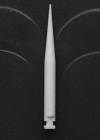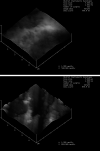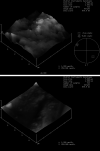Enamel surface roughness after debonding
- PMID: 20677958
- PMCID: PMC8929481
- DOI: 10.2319/012610-55.1
Enamel surface roughness after debonding
Abstract
Objective: To test the hypotheses that (1) there is no significant difference between the effects of two burs on the surface roughness of enamel after orthodontic debonding, and (2) there is no difference between resin removal times of the two burs.
Materials and methods: The crowns of 20 premolars were embedded in acrylic blocks, and the buccal surfaces were subjected to atomic force microscopy (AFM), with measurement of initial roughness values. The brackets were bonded with a light-cured adhesive and were debonded with a debonding plier. In half of samples, adhesive remnants were removed with a tungsten carbide bur, whereas a fiber-reinforced composite bur was used in the other half. The second AFM measurements were made after resin removal. Duration of removal procedures was also recorded. Results of roughness and duration measurements were analyzed with the use of repeated measurements analysis of variance and independent t-tests, respectively.
Results: The two resin removal instruments had significantly different effects on enamel roughness; higher average roughness (Sa) (P < .001), root mean square roughness (Sq) (P = .046), and maximum roughness depth (Smax) (P < .001) values were obtained with use of the tungsten carbide bur. Time required for resin removal with the composite bur was significantly greater than time required with the carbide bur (P < .001).
Conclusion: The hypothesis is rejected. The composite bur used for resin removal creates smoother surfaces after orthodontic bonding; however, the process takes longer than it does when the tungsten carbide bur is used.
Figures








References
-
- Campbell P. M. Enamel surfaces after orthodontic bracket debonding. Angle Orthod. 1995;65:103–110. - PubMed
-
- Rouleau B. D, Jr, Marshall G. W, Jr, Cooley R. O. Enamel surface evaluations after clinical treatment and removal of orthodontic brackets. Am J Orthod. 1982;81:423–426. - PubMed
-
- Hong Y. H, Lew K. K. Quantitative and qualitative assessment of enamel surface following five composite removal methods after bracket debonding. Eur J Orthod. 1995;17:121–128. - PubMed
-
- Howell S, Weekes W. T. An electron microscopic evaluation of the enamel surface subsequent to various debonding procedures. Aust Dent J. 1990;35:245–252. - PubMed
-
- Krell K. V, Courey J. M, Bishara S. E. Orthodontic bracket removal using conventional and ultrasonic debonding techniques, enamel loss, and time requirements. Am J Orthod Dentofacial Orthop. 1993;103:258–266. - PubMed
Publication types
MeSH terms
Substances
LinkOut - more resources
Full Text Sources
Miscellaneous

